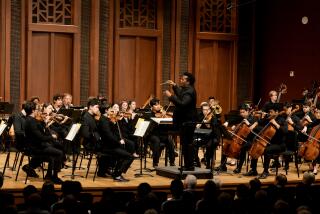‘Partch Dances’ on a grand scale
- Share via
“THE Dreamer That Remains” is Harry Partch’s last piece, written in 1972, two years before his death. It is also the title of a moving film about this eccentric, curmudgeonly composer, who celebrated the dozen years he spent living as a hobo in oddball works such as “U.S. Highball,” who built instruments of extraordinary beauty and weirdness, and who invented a 43-note scale.
And the fact that the dreamer remains was demonstrated Tuesday night by “Partch Dances,” the final concert of this year’s MicroFest, the yearly local festival of microtonal music. Every seat in REDCAT was taken, and the audience was the elusive devoted dream crowd that classical presenters lust after: young and old, hipsters, academics and nerds, all sharing a passion for Partch.
Part of the Partch allure is, of course, the scarcity of live performances. The original instruments are housed at Montclair State University in New Jersey and are too fragile to travel much or cheaply. But Los Angeles guitarist John Schneider has been slowly building replicas and training young musicians to play them. He now has enough Partch instruments to perform some of the classic ensemble pieces, and two were on the program Tuesday, along with film clips from “The Dreamer That Remains.” (The full half-hour film has just been released on an indispensable Partch DVD.)
“Eight Intrusions,” which opened the program, is classic Partch, quirky etudes for a variety of instruments and voices ranging all over the map and history, tapping into Partch’s interests in ancient Greek music, Taoist teachings and 13th century Japanese lyrics. Texts in some numbers also come from a hobo pal, Pablo; from a postwar novel, “Knock on Any Door” (Humphrey Bogart starred in the film); from a Celtic/California poet, Ella Young; and from Zuni Indian chant.
And yet all of this sounded as though it was invented by Partch. How could it sound any other way, what with the cloud chamber bowls -- gongs made out of large Pyrex containers Partch found at the Lawrence Livermore labs in Berkeley -- or the marimba shaped like a diamond with a lot of strange notes that would fit between the cracks of the keys on a piano? Guitars are retuned as well. A kithara has 72 strings, many times more than the ancient Greek plucked instrument. The bass marimba is taller than a basketball player, and its lowest notes are felt as mellow, muscular vibrations as well as heard.
The concert ended with the dance “Castor & Pollux,” which follows the parallel “insemination,” “conception” and “delivery” of both mythical characters and which includes the harmonic canon, a wheezy “off-pitch” organ.
“Sonata Dementia” was advertised as a world premiere of a piece written 55 years ago. In fact, the work is an early version of the 1953 “Ring Around the Moon.” Its movements -- “Abstraction & Delusion,” “Scherzo Schizophrenia” and “Allegro Paranoia” -- thumb their noses at the audience with glee. Schneider also touchingly sang the song cycle “December, 1942” and accompanied himself on adapted guitar.
THE performances were stunning. Partch made a big point of the corporeality of performance. His instruments and tuning were intended to reach a listener physically, even erotically. He wanted performers who were physical presences. And he got them in the likes of Erin Barnes on the diamond marimba, whose performances were spectacular dances in themselves. The same could be said for David Johnson (cloud chamber bowls) and T.J. Troy (bass marimba).
The same, alas, could not be said for the CalArts dance department’s contribution to “Castor & Pollux.” Liz Hoeffner’s sexless, tame, contorted choreography for six women dancers constituted the evening’s inappropriate ninth intrusion.
More to Read
The biggest entertainment stories
Get our big stories about Hollywood, film, television, music, arts, culture and more right in your inbox as soon as they publish.
You may occasionally receive promotional content from the Los Angeles Times.











